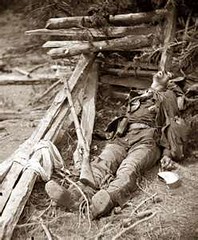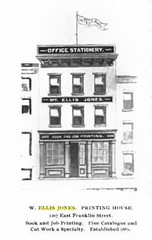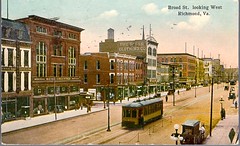Addie Gray Bowles (1881 – 1918)
Addie Gray Bowles enters the Jones family line on October 20, 1898, upon her marriage to F. Ellis Jones. She was born July 31, 1881, the fifth daughter of Drury Wood Bowles (1847 – 1910) and Regina Bowles (ne. Elmore) (1847 – 1906), of Richmond. Her father was the son of an ancient Virginia family whose seat was “Bowlesville”; a large plantation estate in Fluvanna County, Virginia. Her lineage is extremely well established and is documented in the various genealogies of Virginia’s oldest, colonial-era families. I will leave the specifics of her heritage for biographers whose purpose is different than mine. It will suffice to say that F. Ellis married significantly “up” in social class, if not in wealth (as most of the Bowles wealth was destroyed with the Confederacy.) Addie Gray was a warmly welcomed addition to the Jones family.
Like so many of the descendants of the old Southern families in the period after the Civil War, Addie Gray Bowles family’s wealth was history – but her principles and inherited sense of “place” in society was absolutely unshaken. She was raised in an ancient tradition of noblesse oblige that seems almost quaintly old-fashioned to us today. She was well-accomplished in the fine arts of domesticity, and upon entering the Jones household at just seventeen years old, took her place alongside her mother-in-law and her husband’s aunt “Deitz” (Lemira Virginia Smith), making herself indispensable in every way she could think of.
She was a famous cook, a gifted seamstress, and a devoted nurse. She extended her ministrations throughout the neighborhood, attending to the well-being of those less fortunate than herself. She was, as accounted by my Grandfather, one of the kindest and most unselfish individuals he ever knew, as well as exceedingly tolerant and sympathetic to the plight of former slaves and their children who struggled in post-Reconstruction Richmond. If this is true (and I have no reason whatsoever to believe it is not), then Addie Gray Bowles is to be credited – along with “Aunt Dietz” – with injecting into our family line the philosophy and principles of equality, fairness, and tolerance that have been carried through to the present generation.
My grandfather records in our family history that his mother’s life was unremarkable. I tend to believe that every generation is unfair to its parents, and perhaps makes too much romance around the myths of those long since dead. This has to be the case with Addie Gray Bowles, for her life and what little I know of it seem quite remarkable to me. If half of what he wrote about her character and abilities is true, then she was an exceptional person indeed.
In her absolute dedication to her husband’s family, her mother-in-law, Ella Cordelia Jones (ne. Smith), likened Addie Gray to the Biblical Ruth:
“…And Ruth said, Intreat me not to leave thee, or to return from following after thee: for whither thou goest, I will go; and where thou lodgest, I will lodge: thy people shall be my people, and thy God my God…”
– The Book of Ruth 1:15
Addie Gray gave her husband just one child, my grandfather, William Ellis Jones (1899 – 1951.) He was named after his grandfather.
Her father-in-law, William Ellis Jones, died in April of 1910 when his namesake was just a month shy of his tenth birthday. Just a few months later in November of that same year, she lost her husband and was left a twenty-seven year old widow. Instead of remarrying to ensure her own financial security, she redoubled her dedication to her remaining in-laws, her neighbors, her church, and to her sense of duty toward the well-being of those around her. In 1917, she and her now-teenaged son lost yet another close friend and in-law, Lemira Virginia Gibbs (ne. Smith) – the beloved Aunt “Deitz”
This loss was felt especially keenly by young William, who was as devoted to her as to any other member of his extremely close-knit family.
In 1918 when the “Spanish Flu” pandemic swept over Richmond, Addie Gray became a nurse to most of her own family and the neighborhood at large. She opened her home, making it a hospital to her brother’s entire family who were sick with the dreaded and rapidly spreading infection, and she nursed her son through it and saw him recover his health. For months she toiled in hospital rooms and visited the sick all over her neighborhood, trying to bring aid and comfort wherever she could. The many weeks and months of exhausting toil wore down her constitution; by October of 1918 she had contracted the infection herself. She died on October 14, 1918 and was buried in Hollywood Cemetery next to her husband, F. Ellis Jones.
One year later, in 1919, Ella Cordelia Jones (ne. Smith) passed away. Her grandson William was at her side when she took her last breath. She was buried next to her husband in Shockoe Cemetery.
William Ellis Jones, the only child of F. Ellis Jones and Addie Gray Jones (ne. Bowles) was not yet twenty years old when cherished Aunt “Dietz”, his mother, and then his grandmother died in close succession. In the course of less than ten years he had buried every single person who was near and beloved to him.
He was a boy left alone; utterly and completely alone.
—————————————–
Primary Source: The Baby Book / William Ellis Jones Jr. Family History, By William Ellis Jones Junior (1936)












You must be logged in to post a comment.